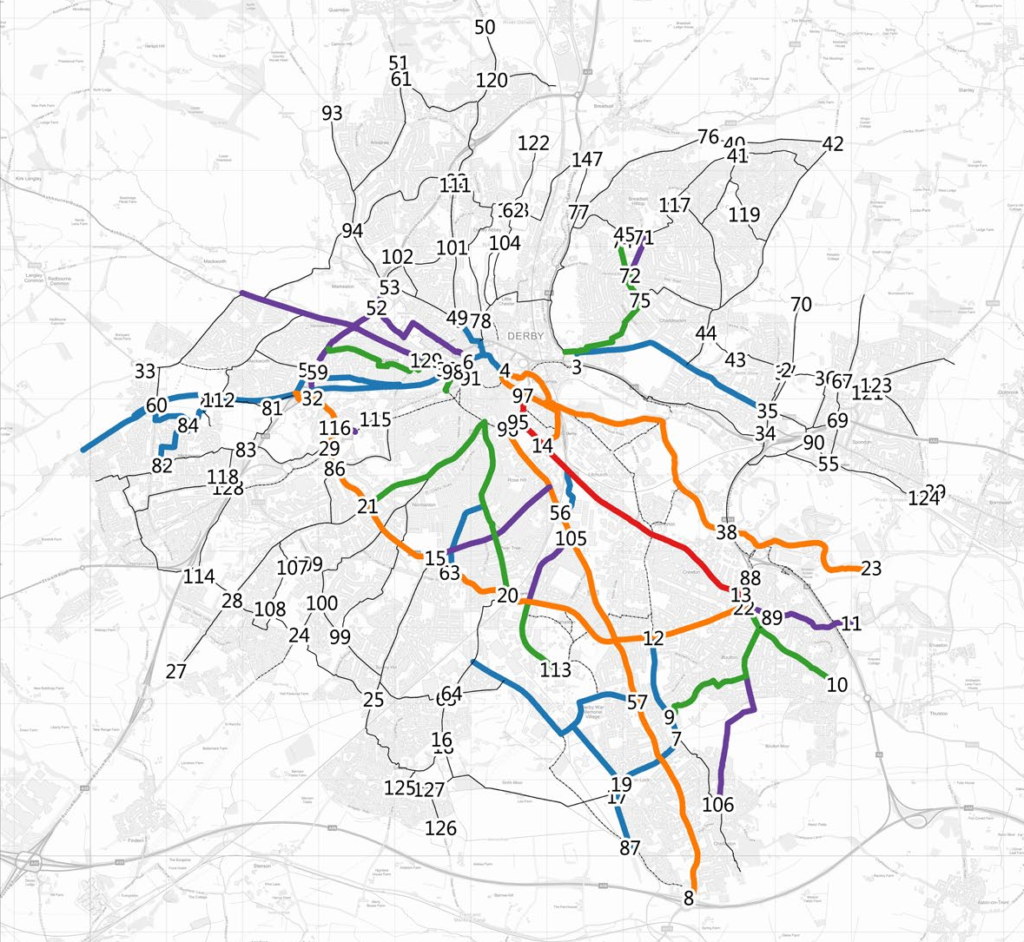Updated: 2nd January 2024
Update: September 2025: Note that most of the links mentioned below are to websites at the local Councils and most no longer are valid. The LCWIP can be found here. None of the comments collected in the 2023 consultation are included.
Update January 2024: With the plans for an East Midlands mayor to be elected in May 2024 and with the future mayor having responsibility for transport, the indications are that none of the involved Councils (including Derby and Derbyshire) are likely to finalise the LCWIP and, instead, will pass it onto the new mayor for consideration on how to proceed. This will mean that there has been no final LCWIP for approx. 7 years! Certainly the mayor should kick off a new version of the draft LCWIP as there have been many changes over the years since the original data was collected.
The Government has asked each Council across the country to create a Local Cycling and Walking Infrastructure Plan (LCWIP). This is an important document as it shows what the Council wish to achieve relating to Active Travel for the next 15 years.
Inclusion in the plan does not mean a project will be implemented (funding or other issues may prevent this) but it is very likely that, if a project isn’t included in the plan, it won’t be funded or built.
For our area, the Councils for Derby City, Derbyshire, Nottingham and Nottinghamshire have worked together (under the banner of the Local Enterprise Partnership – D2N2 LEP) to create a single plan for the region. This SHOULD mean that cross Council routes are considered in a more holistic way than taking a blinkered “just one Council” approach.
The process for creating the LCWIP is for various analyses of possible routes to be done so that a data driven set of prioritised projects can be created. There has been some (limited) engagement with stakeholders, including Derby Cycling Group, but the Government defined process mandates a public consultation before the plan is finalised. This public consultation has been greatly delayed but is now here.
The latest published version of the LCWIP is not a quick read (163 pages – 20MBytes).
As a Group we’re pleased to see the LCWIP nearing completion and agree with a lot of the aims of the document and the process.
The major focus of our feedback can be summarised under the following points:
The need to gain understanding of the plan for Derby and surrounds. The Plan currently does not provide an easily understood map of the routes that are proposed for the Derby area over the next 15 years. This is essential.
The above shows 3 of the different maps included in the documents and close inspection shows inconsistencies.
The delays in the creation (and consultation) process of the Plan are such that a review is now due according to the documented timescales. In addition there have been significant changes in the local priorities (e.g. cancellation of the Toton HS2 Hub, the plans for the East Midlands Intermodal Park near Toyota) requiring that the Plan should be re-assessed. The process of data collection needs to be started now for Version II of the plan.
The stage of the plan for collecting suggestions for possible routes from the public and key stakeholders has been omitted for the Derby area. As part of the work for Version II of the plan, we believe that a formal public suggestion phase should be included to allow for a long list of possible routes to be identified and then analysed. This process was followed by Derbyshire for their Key Cycle Network and a similar process should be repeated for the Derby City area (and its surrounds). As part of this consultation Derby Cycling Group should be identified as a key consultee.
Certainly for the Derby area there has been an exclusive focus on reviewing new possible routes whereas we feel there are also significant benefits to be obtained from connecting together existing (disconnected) routes. We feel the plan should also review the existing disconnects in the local network and these should be included in a prioritisation and implementation plan for a coherent and connected network.
Although the plan has been nominally created across Local Authority borders we feel that, for the area of Derby and its surrounds, this hasn’t been done successfully. A number of key strategic routes within Derbyshire stop at the Derby City boundary. We believe the cross border analysis for the Derby area needs to be redone taking a more holistic approach and not restricting the analysis to the Derby City local authority area.
The standards for implementation of any scheme should be formally adopted by each Council and should be at the level of LTN 1/20 or similar. The standards should also include plans for maintenance of existing and new routes.
Perhaps the most useful part of the document relating to Derby City is the list of prioritised projects in the Delivery Programme at the link here.
The consultation phase has now started and continues until 8th March 2023 and we’d encourage you to review the document and submit your response.
All information from the Councils is here including a link to the survey. Apart from background information on yourself (e.g. do you have a bike), the survey consists of only 3 questions:
- Do you support the ambitions of the LCWIP (yes or no) plus a free format field to support your yes or no answer
- Any comments on the LCWIP document (free format)
- Any other comments (free format)
As a Group we’ve formulated a response to the public engagement process. The response sent to the consultation process on behalf of the Derby Cycling Group can be found here.
The Derby City consultation page and Derbyshire County Council consultation page link to the D2N2 page.



